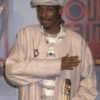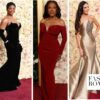Imagine that you grow up, literally, in the hotel industry. Your parents run an iconic pub and boutique hotel in Washington, D.C., where you spend your teenage summers cleaning rooms and working the checkout desk. After college, you intern at Hilton, go to business school, and then join the finance department of Marriott International, the largest hotel company in the world.
Over the next 25 years, you rise through the ranks to become one of Marriott’s most senior executives, and its highest-ranking woman, telling Fortune in 2015 that “anyone can make it to the top here if you work really hard.” And by 2021, when you’re named one of two executives sharing the duties of acting CEO and likely in line to become the next chief executive, it seems like your lifelong devotion to this industry is about to pay off.
And then you don’t get the job. What do you do next?
For Stephanie Linnartz—the former president of Marriott, and now the CEO of struggling sportswear company Under Armour—the answer was: Find one of the biggest turnaround jobs out there, and get back to work.
“Why things happen, we don’t ever know for sure,” she tells me during an interview at the new corner office that she’s still settling into, overlooking Baltimore’s Inner Harbor. “But life’s all about timing—and I always had this idea that the rewards of taking risks are, the great majority of the time, worth it.”
On the surface, Linnartz’s decision to jump to a bro-y sportswear retailer seems like an odd fit for an executive who’s spent her career in luxury hotels. It even required a personal-style pivot: At Marriott, “I wore dresses and high heels every day,” she reminisces, but during our interview she sports her new executive uniform of Under Armour sneakers and a white zip-up jacket. And the challenges go far beyond fashion. Linnartz is several months into what she has called a three-year turnaround plan, for a once-buzzy brand that has seen its growth stagnate and share price plummet in the past decade. (Under Armour is also a much smaller company, with only $5.9 billion in revenue and 15,000 employees, to Marriott’s $20.8 billion and 140,000.) And she’s coming in as an outsider to a founder-dominated company still controlled by executive chairman Kevin Plank, four years and three chief executives after he “stepped down” from his CEO role.
“She obviously has an important voice and an important role, and I’m sure that she will exert influence,” says Neil Saunders, a GlobalData Retail analyst who covers Under Armour. But “it’s very difficult, when you have someone who founded the business and still has very strong views about the business, calling some of the shots.”
Still, Linnartz wanted to be a chief executive—and when the obvious path to that role closed at Marriott, she followed the advice she’s given to many other women over the years. “Take the toughest, most difficult job or project someone can give you, because that’s how you move ahead,” is how Linnartz characterized her career philosophy to Fortune eight years ago.
Her new job certainly seems to fit the bill. “There are challenges,” she acknowledges. “And we’ll face them.”
Under Armour, as even its employees admit, has been in trouble for a long time.
Plank started the company in his grandmother’s basement in 1996, as I was told multiple times by multiple people over the course of three hours at Under Armour headquarters in August. He was inspired by his time playing college football for the University of Maryland, where he regularly sweated through cotton shirts ill-equipped to handle an athlete’s perspiration. His startup first defined itself as a founder-led seller of performance gear, one that today has a team of employees devoted to developing “revolutionary yarn” and that boasts about using “over 10,000 fabrics in our history”—most of them optimized to reduce the amount of sweat you have to deal with while performing very sweat-heavy physical feats.
And for a while, Under Armour was cool. It won endorsements and signed deals with a wide range of high schools, colleges, and professional athletes, including heavy hitters: NBA superstar Steph Curry, college football powerhouse Notre Dame, even professional ballerina Misty Copeland. In 2005, less than 10 years in, Under Armour went public, successfully—its shares doubled within the first day of trading, making it the first U.S. company in five years to have such a pop. The share price peaked at a split-adjusted high of $52 in 2015, as the company’s annual revenues were soaring by 28%.
But in 2023, Under Armour is struggling to grow sales or profits, and its shares are trading around $6.50. The company hasn’t accumulated the sneakerhead cred or ongoing athlete endorsements of Nike and Adidas, and its historical focus on performance, rather than fashion, has made Under Armour a lagging player in the pandemic-era athleisure boom that turned Lululemon into a juggernaut. Deadspin recently called it the “worst sports apparel company of the past 20 years,” and analysts concur that it’s “a second-tier brand,” as Saunders says. “What’s gone wrong with Under Armour is what’s always been wrong: Under Armour doesn’t really know what it is.”
–87%
Change in Under Armour’s share price since its 2015 peak. As of 9/21/23
Without many of its own stores, and without the high-polish e-commerce reputation of younger competitors, Under Armour sits in an awkward retail spot. It still relies too much on third-party retailers to sell its stuff, something that Linnartz and other executives acknowledge has led to an “inconsistent” reputation in the U.S.: Today, Under Armour might be best described as something that teenage boys’ moms buy for them, on sale, at Kohl’s.
But for the woman who jumped into this turnaround job, “there’s tremendous upside,” Linnartz claims. “There’s incredible love for the brand, globally—and so I’m super excited about it.”
The oldest of six children in an Irish American family, Linnartz grew up in northern Virginia—not far from the Maryland headquarters of Marriott and now Under Armour. One brother still runs the Dubliner pub, a Capitol Hill hangout that has hosted U.S. presidents and Irish ambassadors as well as plenty of locals and tourists. In person, Linnartz doesn’t come across as a chatty publican’s daughter—she’s warm but brisk, and deftly swats most questions back toward her corporate talking points. But she’s inherited a relish for focusing on customers’ experiences. She also has an affinity for complex challenges. As she climbed the ranks at Marriott, she became known for taking on projects “that were lying in plain sight, that were hard, and that needed to be tackled,” says Jim Dausch, Marriott’s former chief product and digital officer, who in June left the hotel chain after 20 years to reunite with Linnartz as Under Armour’s chief consumer officer.
For example, after Marriott purchased Starwood in 2016 for $13 billion, Linnartz oversaw the massive integration between two operating systems, including the customer-loyalty programs that are so crucial for repeat business in the hospitality industry. She ultimately built its Marriott Bonvoy rewards platform, now the world’s largest such hospitality program, with 186 million members. And according to Dausch, she also kick-started a complicated and expensive overhaul of the back-end tech behind Marriott’s disparate systems. That project was becoming more high-stakes as the company expanded into all-inclusive resorts and residences and other operations, but it was one where “the company had always kind of kicked the can down the road,” Dausch says. “After the Starwood integration was over, Stephanie was the one to say, ‘We have to take this on’ … She really led that charge.”


Courtesy of Under Armour
The last few years of Linnartz’s tenure at Marriott were overshadowed by global and personal tragedies. The pandemic upended the hotel industry; Marriott laid off tens of thousands of workers and shed $10 billion in revenue in 2020, as travel ground to a halt. At the same time, its widely respected CEO, Arne Sorenson, was fighting pancreatic cancer. In February 2021, he stepped back from running the company, which said that Linnartz and fellow top executive Tony Capuano would take over his day-to-day responsibilities. Two weeks later, Sorenson died—and before the end of the month, Marriott’s board announced that Capuano would be the next CEO. Linnartz was named president, in charge of running global consumer strategy, as well as development, technology, and emerging business.
Hospitality insiders praise Capuano, a veteran development executive under whom Marriott’s stock has risen more than 31%. But some mourn the symbolic missed opportunity of Linnartz not getting the CEO role, in a relatively small travel industry where only 30% of senior executives are female and very few run large hotel or airline companies. “I think most women in the industry were disappointed that it wasn’t a woman,” says Flo Lugli, a hotel industry consultant and former senior executive at Wyndham and Radisson. “But Marriott has a great reputation of developing good leaders.”
For almost two more years, Linnartz was a good soldier. But “I’ve always been a big believer in taking risk, and saying, ‘How can I grow myself as a leader and a human being?’ ” she says. When one CEO left Under Armour in June 2022 and the board started looking for a permanent replacement, “I was ready to take that next leap.”


A runner and a fierce football fan, Linnartz says going to Under Armour wasn’t as big a career leap as it first appears. And there’s another way in which her résumé has prepared her for some of the company’s challenges: At Marriott, which is still 16% owned by the eponymous Marriott family and where the founders’ descendants still very much have a voice, Sorenson in 2012 became the first non-family CEO in the company’s then-85-year history.
So Linnartz knows how to work for a company where keeping the founder happy is part of the job. The challenge, with Under Armour, will be doing so while cleaning up some of the problems created on his watch. Plank—or “KP,” as longtime employees call him—occupied the CEO’s office for 24 years. His origin story is still fetishized, to a near-cultish degree, at headquarters: Buildings and apparel lines are numbered either 96 (for the year he founded Under Armour) or 37 (for the number of KP’s college football jersey). One corridor at headquarters is decorated with an enormous photo of that jersey, next to blown-up versions of Plank’s early Under Armour business cards, next to #inspo phrases like “HUMBLE & HUNGRY BEGINNINGS.”
For a long time, Plank was Under Armour’s best brand ambassador—until he started landing the company in the middle of ugly controversies. In 2017, he publicly praised President Trump—to the vocal displeasure of Under Armour’s celebrity spokespeople, including Curry and Copeland—before reversing course and resigning from the president’s business council over Trump’s response to the racist violence in Charlottesville, Va. Then, in 2018, the Wall Street Journal broke a series of stories on inappropriate workplace behavior and a sexualized culture at Under Armour; Plank and his executives even attended company-paid trips to strip clubs, the Journal reported. And in 2021, the company agreed to pay $9 million to settle an SEC investigation into financial disclosure failures dating back six years. At the beginning of 2020, Plank nominally stepped down from leading Under Armour, keeping his “executive chairman” role and naming company president Patrik Frisk CEO.


Patrick T. Fallon—Bloomberg via Getty Images
But as several chief executives elsewhere in the corporate world have discovered to their dismay in recent months, “executive chair” often means “CEO by any other name.” Frisk, interim CEO Colin Browne, and now Linnartz have all reported to Plank, who owns 65% of Under Armour’s voting shares. And outside the boardroom, KP’s public profile continues to create headaches; two days before I interviewed Linnartz for this article, unsealed court documents in a six-year-old shareholder lawsuit revealed that Plank had shared nonpublic financial information with television journalist Stephanie Ruhle. The revelations of the inappropriate-at-best relationship made widespread, gossipy headlines.
“I don’t tolerate gossip—and for many people here, this is old news,” says Linnartz, adding that her approach involved “leaving some of the noise aside, that has nothing to do with the business, to focus on what is terrific about Kevin, and inspiring as only a founder can be.”
Plank, for his part, declined multiple interview requests for this article. A spokesperson said that he was traveling, and sent along an emailed statement calling Linnartz “the obvious choice” for CEO. “She has hit the ground running, launching a clearly articulated three-year strategy that sets us up for strategic growth,” Plank wrote. “I could not be more excited to have her at Under Armour and to work with her every day.”
However Linnartz navigates her relationship with her executive chairman over the coming months, she has plenty of cautionary tales. Recent years have given us several examples of ambitious, experienced executives—often women—who take on a CEO job that involves working for a predecessor or founder, and trying to keep him happy while fixing some of the problems he created. There’s Linda Yaccarino, the former NBCUniversal executive who’s now enthusiastically embracing whatever Elon Musk has turned Twitter into. There’s Roz Brewer, the former Starbucks chief operating officer who became Walgreens CEO in 2021—and who abruptly left in late August, after two and a half years of working for Stefano Pessina, the executive chairman and largest shareholder at Walgreens. And there’s Sonia Syngal, whose 2022 exit from Gap Inc. came after two years of trying to turn around a retailer that’s more than 40% owned by its founding family. (The departures of Syngal and Brewer, who had been one of only two Black female CEOs running a Fortune 500 company, also represented losses specifically for women of color.)
A runner and a fierce football fan, Linnartz says going to Under Armour wasn’t as big a career leap as it first appears. “There’s incredible love for the brand,” she says.
Everyone has a boss to keep happy—even ridiculously well-compensated CEOs—and the vagaries of working for the guy you’re supposedly replacing aren’t always gendered. But it’s striking how many ambitious women, still, have to take such risks in order to get a shot at the top spot in corporate America, where women account for barely 10% of Fortune 500 CEOs. The career choices made by Brewer, Yaccarino, and potentially Linnartz also raise questions about how much executives still have to navigate the “glass cliff,” the data-backed phenomenon in which women have to accept riskier opportunities in order to advance.
So is this the tightrope Linnartz is walking at Under Armour? Probably—but “I don’t focus on that,” Linnartz says. “I believe in taking calculated risks. I don’t believe in being reckless.” And according to her friends and colleagues, she has the work ethic—and the courage—to pull Under Armour and her career back from this potential brink.
“She’s very data-driven, she’s got great judgment, and she doesn’t underestimate” how much work something will be, says Accenture CEO Julie Sweet, No. 2 on this year’s Fortune Most Powerful Women list, who got to know Linnartz through her company’s consulting work for Marriott. (Under Armour has also been an Accenture client.)
“She knows what the challenges are,” Sweet adds, “and she’s going to absolutely overcome them.”


Six months in, Linnartz has already taken some pages from the hospitality-industry playbook—especially her experience pulling in Starwood’s beloved loyalty program, and creating Marriott Bonvoy. In July, Under Armour launched a UA Rewards program that Linnartz argues is about getting customers more excited about Under Armour—by promising them access to sports tickets or special events with celebrity athletes or early entry to sneaker launches—as much as it is about pushing merchandise. “It’s not just a transactional program,” she says. “It’s about building those connections with the customer, and building that love for the brand.”
The company has re-signed some important endorsement deals this year, including with Curry and Notre Dame. More broadly, Linnartz tells Fortune, she wants to expand what Under Armour is known for, especially by increasing its offerings in footwear, “sport style” athleisure, and female-focused clothing. (Women currently account for less than 25% of Under Armour’s business.) She also has articulated a strategy of building “brand heat”—or courting a more elite reputation in the United States—by expanding Under Armour’s own full-price stores and direct-to-consumer channels, while paring back on its sales through third-party partners.
It’s a lot of expansion initiatives at once, especially for a brand still struggling with inconsistency, and investors aren’t yet won over: The company’s shares are down 25% since Linnartz took over in February. But the new strategies certainly bear her stamp. And hotel industry insiders argue that Linnartz’s ability to keep many plates spinning at once, while overseeing the global consumer operations of Marriott’s 30 brands and then-8,200 properties, might be exactly the experience Under Armour needs.
“Marriott has an incredible breadth of operations, and it’s attempted to redefine itself as an organization that doesn’t just give you a room and a bath and a roof over your head, but tries to create a sense of style, and a sense of belonging,” says Sean Hennessey, a hotel industry consultant and associate professor at NYU’s Tisch Center of Hospitality. “Under Armour is very much in that vein of trying to appeal to people that don’t just need a T-shirt or shorts, but who dress in that clothing because it says something about the type of people that they are.”
For her part, Linnartz isn’t giving up on her Marriott loyalty—even though her new boss is a hotelier himself, and has invested in a high-end boutique hotel near Under Armour’s offices. At a certain point during our interview, when I mention the less-than-amazing experience I had at a Marriott-operated property across the Inner Harbor from Under Armour’s headquarters, she nods knowingly: “That hotel needs help.” Then she laughs: “But don’t call me about that now.”
Still, “I spent 25 years of my life there—and it was a very defining part of my life,” Linnartz reflects. “I will always be loyal to Marriott.” Now it’s time to move on, and hopefully—if she manages to pull off this “toughest, most difficult job”—to move ahead.
This article appears in the October/November 2023 issue of Fortune with the headline, “Stephanie Linnartz bets on an underdog.”
This post was originally published on this site be sure to check out more of their content.








